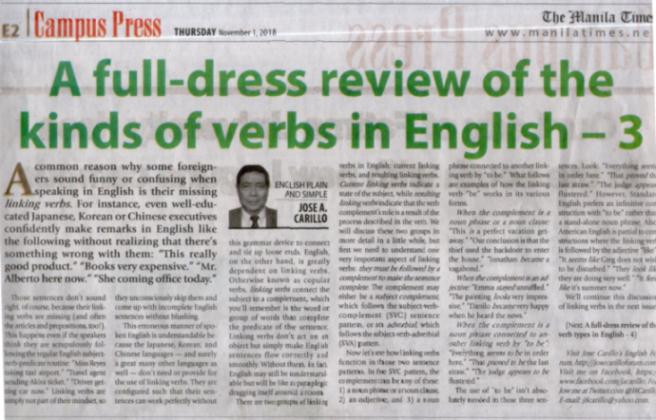Verbs to connect and tie up loose ends- 1A common reason why some foreigners sound funny or confusing when speaking in English is their missing
linking verbs. For instance, even well-educated Japanese, Korean, or Chinese executives confidently make remarks in English like the following without realizing that there’s something wrong with them: “This really good product.” “Books very expensive.” “Mr. Alberto here now.” “She coming office today.”
Those sentences don’t sound right, of course, because their linking verbs are missing (and often the articles and prepositions, too!). This happens even if the speakers think they are scrupulously following the regular English subject-verb-predicate routine: “Miss Reyes taking taxi airport.” “Travel agent sending Akira ticket.” “Driver getting car now.” Linking verbs are simply not part of their mindset, so they unconsciously skip them and come up with incomplete English sentences without blushing.
This erroneous manner of spoken English is understandable because the Japanese, Korean, and Chinese languages—and surely a great many other languages as well—don’t need or provide for the use of linking verbs. They are configured such that their sentences can work perfectly without this grammar device to connect and tie up loose ends. English, on the other hand, is greatly dependent on linking verbs. Otherwise known as
copular verbs, linking verbs connect the subject to a
complement, which you’ll remember is the word or group of words that complete the predicate of the sentence. Linking verbs don’t act on an object but simply make English sentences flow correctly and smoothly. Without them, in fact, English may still be understandable but will be like a paraplegic dragging itself around a room.
There are two groups of linking verbs in English: current linking verbs, and resulting linking verbs.
Current linking verbs indicate a state of the subject, while
resulting linking verbs indicate that the verb complement’s role is a result of the process described in the verb. We will discuss these two groups in more detail in a little while, but first we need to understand one very important aspect of
linking verbs: they must be followed by a complement to make the sentence complete. The complement may either be a
subject complement, which follows the subject-verb-complement (SVC) sentence pattern, or an
adverbial, which follows the subject-verb-adverbial (SVA) pattern.
Now let’s see how linking verbs function in those two sentence patterns. In the SVC pattern, the complement can be any of these: (1) a noun phrase or a noun clause, (2) an adjective, and (3) a noun phrase connected to another linking verb by “to be.” What follows are examples of how the linking verb “be” works in its various forms.
When the complement is a noun phrase or a noun clause: “This
is a perfect vacation getaway.” “Our conclusion
is that the thief used the backdoor to enter the house.” “Jonathan
became a vagabond.”
When the complement is an adjective: “Emma
stayed unruffled.” “The painting
looks very impressive.” “Danilo
became very happy when he heard the news.”
IMAGE CREDIT: VOCABULARYPAGE.COMWhen the complement is a noun phrase connected to another linking verb by “to be”: “Everything
seems to be in order here.” “That
proved to be the last straw.” “The judge
appears to be flustered.”
The use of “to be” isn’t absolutely needed in those three sentences. Look: “Everything
seems in order here.” “That
proved the last straw.” “The judge
appears flustered.” However, Standard English prefers an infinitive construction with “to be” rather than a stand-alone noun phrase. Also, American English is partial to constructions where the linking verb is followed by the adjective “like”: “It
seems like Greg does not wish to be disturbed.” “They
look like they are doing very well.” “It
feels like it’s summer now.”
IMAGE CREDIT: SLIDEPLAYER.COMWe’ll continue this discussion of linking verbs in the next issue.
This essay first appeared under the title “Verbs to tie up loose ends” in the weekly column “English Plain and Simple” by Jose A. Carillo in The Manila Times
and it subsequently appeared in his book English Plain and Simple: No-Nonsense Ways to Learn Today’s Global Language
, ©2004 by Jose A. Carillo, ©2008 by the Manila Times Publishing Corp. All rights reserved.
(Next:
A full-dress review of the verb types in English - 4) November 8, 2018